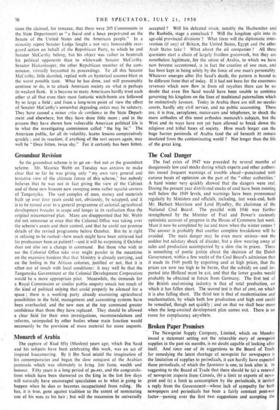The Coal Danger
The fuel crisis of 1947 was preceded by several months of dangerously low coal stocks during which experts and other authori- ties issued frequent warnings of trouble ahead—punctuated with curious bouts of optimism on the part of the " other authorities." A hard winter very quickly showed that the dangers were real. During the present year distributed stocks of coal have been running well below the 1949 levels, and warnings have been pronounced regularly by Ministers and officials, including, last week-end, both Mr. Herbert Morrison and Lord Hyndley, the chairman of the National Coal Board. The parallel with 1946 was further strengthened by the Minister of Fuel and Power's curiously optimistic account of progress in the House of Commons last week. Must it now be completed by ice and snow when the winter comes ? The answer is probably that another complete breakdown will be avoided. The main danger may be even more serious—not the sudden but salutary shock of disaster, but a slow wearing away of sales and production accompanied by a slow rise in prices. There is something of poetic justice about the decision of the Dutch Government, within a few weeks of the Coal Board's admission that it made its 1949 profit by exporting coal at high prices, that the prices are now too high to be borne, that the subsidy on coal im- ported into Holland must be cut, and that the lower grades would probably be obtained in future from Germany. The first test of the British coal-mining industry is that of total production, on which it has fallen short. The second test is that of cvst, on which it is also falling short. The third test is that of modernisation and mechanisation;by which both low production and high cost could be remedied, though not quickly ; and on that we shall hear more when the long-awaited development plan comes out. • There is no room for complacency anywhere.


































 Previous page
Previous page